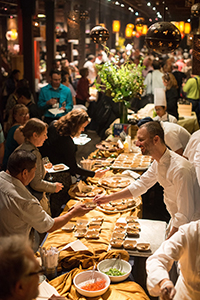Asian Flavors Come Alive at CIA’s Worlds of Flavor
Wednesday, 08 July 2015 03:00
 For 17 years, Worlds of Flavor in Napa Valley has been considered by the industry to be America’s most influential professional forum on world cuisines, food cultures and flavor trends. This year’s event didn’t disappoint.
For 17 years, Worlds of Flavor in Napa Valley has been considered by the industry to be America’s most influential professional forum on world cuisines, food cultures and flavor trends. This year’s event didn’t disappoint.
The trend to Asian tastes and techniques has been growing exponentially in the United States for years. It never came together with such enthusiasm and promise as it did at the 17th Worlds of Flavor® International Conference and Festival, held in April on the Greystone campus of The Culinary Institute of America in Napa Valley in front of an audience of more than 700 culinary, foodservice and hospitality professionals.
“The vastly varied cuisines of Asia are deeply rooted in traditions that have evolved over millennia,” said Greg Drescher, vice president of strategic initiatives and industry leadership at the CIA. “Today, American chefs are embracing and experimenting with what once was considered exotic. These foods and flavors are poised to continue their ascendance and become ever-bigger players in our national dining scene, whether it is in small independent restaurants, high-volume operations, food trucks or university cafés.”

 An understanding of “putting in place” is one of the most important skills for culinary students to learn and practice in becoming professionals. Says Dr. Mayo, proper mise en place is actually composed of three parts—all of which do double duty in the kitchen and dining room.
An understanding of “putting in place” is one of the most important skills for culinary students to learn and practice in becoming professionals. Says Dr. Mayo, proper mise en place is actually composed of three parts—all of which do double duty in the kitchen and dining room. Telling people to be the best they can be allows them to quit striving whenever they want. To be the best in your field, however, one must always strive for the next level. This is the generations-long American Dream that we, as teachers, offer our students.
Telling people to be the best they can be allows them to quit striving whenever they want. To be the best in your field, however, one must always strive for the next level. This is the generations-long American Dream that we, as teachers, offer our students. What can the graduate do for the school? Says Chef Sorgule, the proper question should be, What can the school do for the graduate?
What can the graduate do for the school? Says Chef Sorgule, the proper question should be, What can the school do for the graduate?